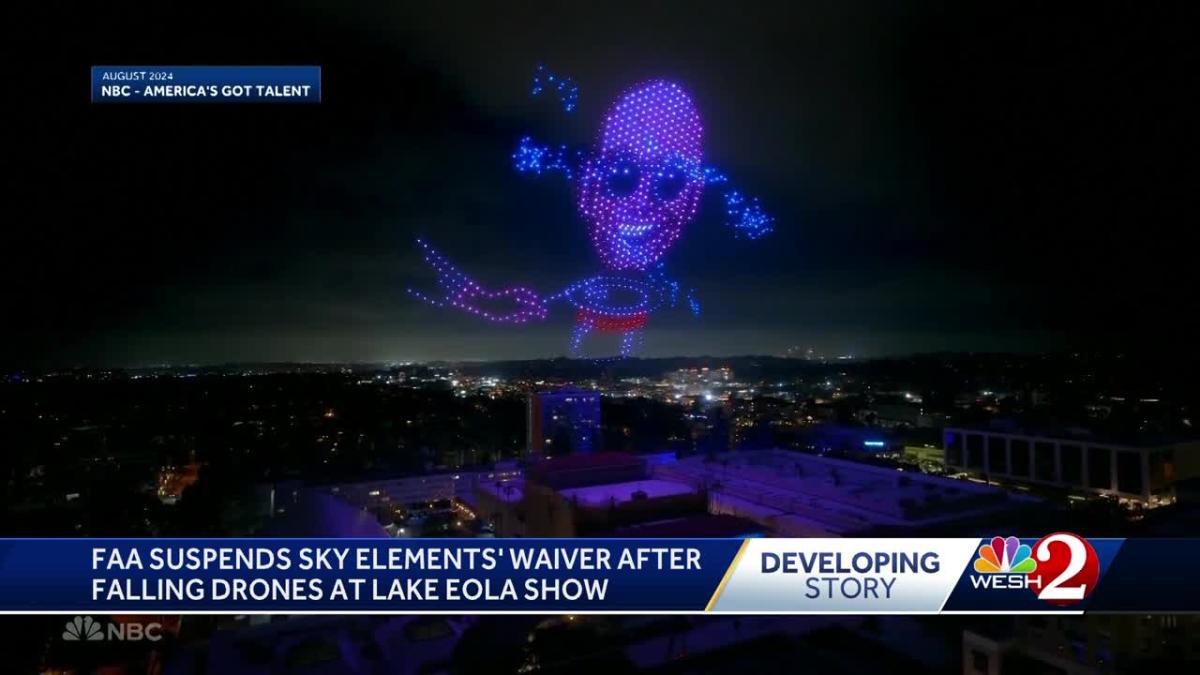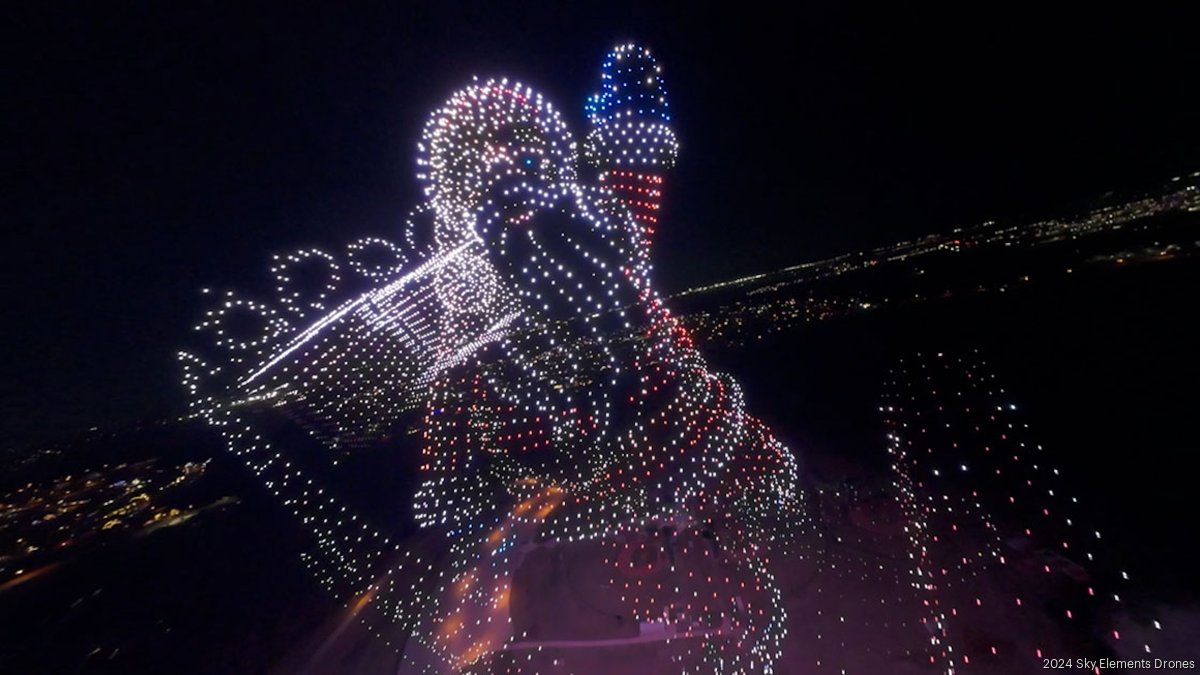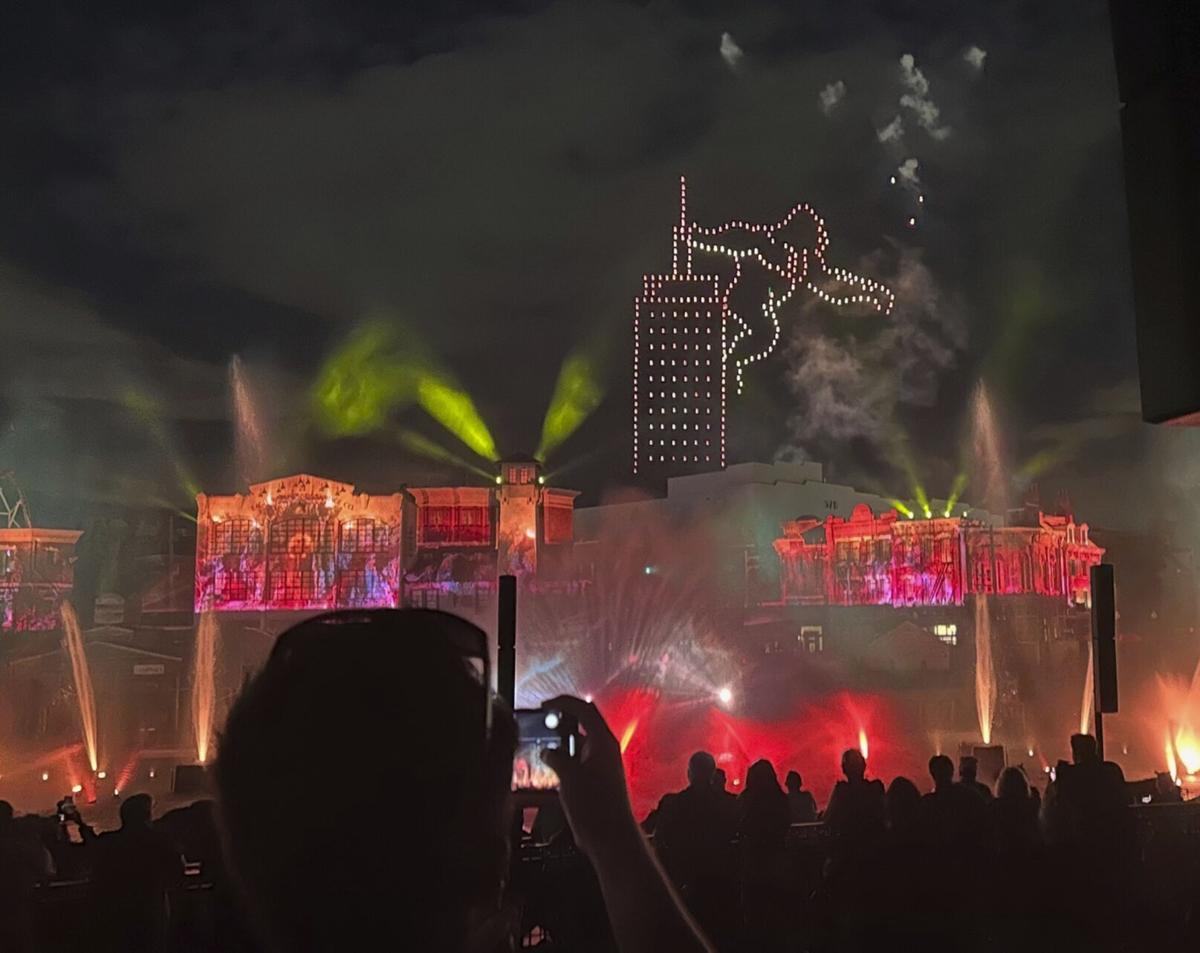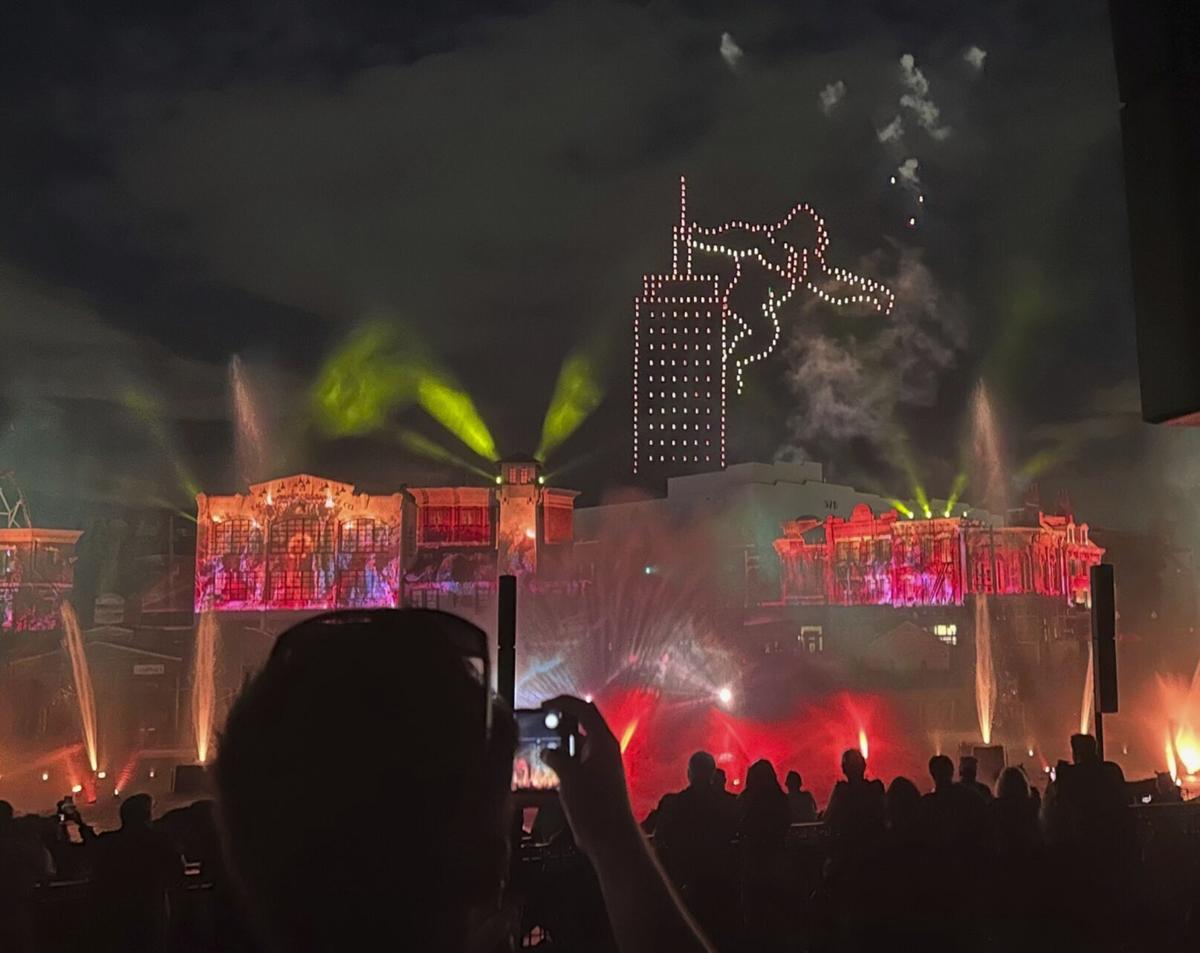Orlando drone show accident: A spectacular drone show turned unexpectedly tragic, leaving us to question safety protocols, technological limitations, and human error. This incident serves as a stark reminder of the potential risks involved in even the most meticulously planned events, highlighting the need for stringent regulations and advanced safety measures. We’ll delve into the details of what happened, explore the contributing factors, and examine the steps that can be taken to prevent similar accidents in the future.
This analysis will cover everything from the specific circumstances of the accident—including the types of drones used, the weather conditions, and a detailed timeline—to the regulatory aspects and potential technological failures. We’ll also explore the human factors involved, such as pilot training and communication protocols, and examine the aftermath, including investigations and public reaction. The goal is to understand what went wrong and how we can make drone shows safer.
Accident Details

The Orlando drone show accident, while still under investigation, involved a malfunction during a large-scale public display. The incident highlighted potential safety concerns associated with large-scale drone operations and spurred renewed discussion about regulatory frameworks. Further investigation will determine the precise cause and contribute to improved safety protocols.
Drone Specifications and Types
The accident involved a fleet of commercially available drones, likely modified for synchronized flight and light displays. While the exact models and specifications haven’t been publicly released pending the investigation, it’s likely they were quadcopter drones equipped with LED lights for the show. These drones are typically equipped with GPS modules for autonomous navigation and sophisticated flight controllers for coordinated movements.
The size and weight would likely fall within the common range for commercial drones used in such displays, allowing for both maneuverability and sufficient payload for the lighting systems.
Timeline of Events
The drone show began as scheduled, with hundreds of drones taking to the sky to create the planned visual effects. At a specific point during the performance, approximately [Insert Time if available, otherwise remove this sentence and the next one], a number of drones experienced a malfunction, resulting in a deviation from the programmed flight path. The exact nature of the malfunction is yet to be definitively determined.
Reports suggest that some drones may have experienced a loss of signal or a system error, causing them to fall from the sky. The show was immediately halted, and emergency personnel responded to the scene.
Weather Conditions
The weather at the time of the incident was reported as [Insert weather conditions at the time of the accident, including temperature, wind speed, precipitation, etc. If unavailable, remove this entire paragraph]. These conditions may or may not have played a role in the accident, a factor that will be addressed during the official investigation. Adverse weather conditions can significantly impact drone performance, affecting GPS accuracy and battery life.
Summary Table
| Date | Time | Location | Drone Type | Initial Reported Cause |
|---|---|---|---|---|
| [Insert Date] | [Insert Time] | Orlando, Florida [Insert Specific Location if available] | Commercial Quadcopter Drones (Specific model pending investigation) | Malfunction; Cause under investigation (Potential causes include GPS interference, system error, or unforeseen weather impact) |
Injuries and Damages
The Orlando drone show accident resulted in a range of injuries and damages, impacting individuals, property, and the environment. Understanding the extent of these consequences is crucial for assessing the overall impact of the incident and implementing preventative measures for future drone operations. The following details provide a summary of the known effects.
Personal Injuries
Reports indicate several spectators sustained minor injuries during the accident. These included lacerations from falling debris, bruises from panicked crowd movements, and a few cases of minor concussion. Fortunately, no fatalities were reported, and most injuries were treated at the scene or in nearby hospitals and released the same day. The precise number of injured individuals and the severity of their injuries are still being compiled by emergency services and may vary slightly depending on the final reports.
Property Damage
The primary property damage stemmed from the malfunctioning drones themselves. Several drones crashed into nearby structures, causing damage to the roofs and exterior walls of several buildings. One report indicated a significant dent in a parked car, likely caused by a falling drone. The total cost of repairing this property damage is currently being assessed and will likely be substantial.
Furthermore, the cleanup of drone debris and damaged parts scattered across the event area also added to the overall cost.
Environmental Impact, Orlando drone show accident
The environmental impact was relatively minor, given the scale of the accident. The primary concern involved the scattered drone parts, some of which contained lithium-ion batteries. These batteries posed a small risk of fire or chemical leakage, but emergency response teams quickly secured and removed the debris, mitigating any potential long-term environmental damage. No significant pollution or habitat disruption was reported.
Summary of Injuries and Damages
- Personal Injuries: Several minor injuries reported, including lacerations, bruises, and a few cases of minor concussion. No fatalities.
- Property Damage: Damage to building roofs, exterior walls, and at least one vehicle. Extensive cleanup required.
- Environmental Impact: Minor, primarily related to the disposal of drone debris containing lithium-ion batteries. No significant pollution or habitat disruption.
Regulatory Aspects

The Orlando drone show accident highlights the critical need for robust and consistently enforced regulations governing drone operations, especially in densely populated areas and during public events. Understanding the existing regulations and identifying potential violations is crucial for preventing future incidents and ensuring public safety.The Federal Aviation Administration (FAA) is the primary regulatory body for drone operations in the United States.
Specific regulations, such as those found in Part 107 of the FAA regulations, Artikel requirements for drone pilot certification, operational limitations (including airspace restrictions and weight limits), and safety protocols. Florida may also have its own state-level regulations that add further restrictions or requirements. These regulations aim to balance the growing use of drones with the need to protect public safety and airspace integrity.
Relevant Regulations and Potential Violations
The FAA’s Part 107 regulations, among others, likely apply to drone shows in Orlando. These regulations cover aspects such as pilot certification, pre-flight inspections, operational limitations, and emergency procedures. A thorough investigation into the accident would need to determine if any of these regulations were violated. For instance, violations could include operating the drone beyond visual line of sight (BVLOS), failing to maintain adequate distance from obstacles or people, operating without the necessary permits or certifications, or neglecting pre-flight checks.
A comparison with the operator’s flight plan and actual flight path would be vital in this process. The absence of a safety observer, or a failure to adequately communicate with air traffic control, could also be identified as violations.
Comparison of Safety Protocols and Best Practices
Existing safety protocols for drone shows may vary significantly. Best practices often involve comprehensive risk assessments, detailed flight plans with multiple layers of redundancy (e.g., backup systems and fail-safes), rigorous pilot training and experience, and the implementation of a robust communication system between the pilot and ground crew. The use of geofencing technology to restrict drone operation within a designated area is also a best practice.
In contrast, inadequate safety protocols could involve a lack of pre-flight checks, insufficient pilot training, or the absence of emergency procedures. A comparison of the safety protocols used in the Orlando drone show with established best practices would illuminate potential areas for improvement.
Hypothetical Improved Safety Regulations
Based on the accident, hypothetical improvements to safety regulations could include stricter requirements for pilot certification, including more extensive training on emergency procedures and risk mitigation strategies. Mandating the use of redundant systems and fail-safes, as well as requiring real-time monitoring of drone performance and environmental conditions, would also enhance safety. Furthermore, increased emphasis on pre-flight inspections and risk assessments, including consideration of factors such as weather conditions and proximity to populated areas, is warranted.
The implementation of a more stringent permit process for drone shows in densely populated areas, requiring detailed safety plans and risk mitigation strategies, could also contribute to preventing future accidents. Finally, a clear protocol for communication and coordination with air traffic control and emergency services would be vital. A system for regular audits and inspections of drone show operators could also ensure compliance and identify potential safety hazards before they result in an accident.
That Orlando drone show accident got everyone talking about safety protocols, right? It made me think about other similar incidents, like that drone crash in Paris which highlighted the importance of redundancy systems. Ultimately, both incidents underscore the need for better regulations and more robust fail-safes in drone operations, especially for large-scale shows like the one in Orlando.
Technological Factors

The Orlando drone show accident highlights the critical role technology plays in the safety and success of such events. A complex interplay of hardware, software, and communication systems contributes to the overall performance, and failures in any of these areas can have devastating consequences. This section examines the potential technological factors that may have contributed to the accident.
GPS Malfunction and Software Glitches
GPS signal interference or malfunction is a significant concern in drone operations. Obstacles, atmospheric conditions, or even deliberate jamming can disrupt the GPS signal, causing drones to lose their position and deviate from their programmed flight paths. Similarly, software glitches within the drone’s flight controller or the show’s central control system could lead to unexpected maneuvers or complete system failures.
For instance, a bug in the flight path algorithm could cause multiple drones to converge on a single point, resulting in collisions. A failure in the fail-safe mechanisms, designed to prevent such collisions, would exacerbate the problem.
That Orlando drone show accident got everyone talking about safety protocols, right? It makes you think about similar incidents, like the recent drone crashes in Paris , which highlighted the need for better airspace management. Ultimately, both incidents underscore the importance of robust safety measures for all drone operations, regardless of scale or location.
Communication Systems and Their Effectiveness
Effective communication is crucial for coordinating a large-scale drone show. The communication system used needs to be robust, reliable, and capable of handling the high volume of data transmitted between the control center and the individual drones. Potential issues could include signal loss, latency (delay in data transmission), or interference from other radio frequencies. The effectiveness of the communication system directly impacts the ability to remotely control and monitor the drones, and a failure in this system could lead to a loss of control over the drones.
For example, a delay in receiving commands could cause drones to miss their designated positions, resulting in collisions or other accidents.
Battery Life and Power Management
Battery life and power management are critical factors in drone operations, especially during extended shows. Insufficient battery capacity or inefficient power management can lead to premature battery failure, causing drones to lose power mid-flight. This could result in uncontrolled descents or crashes. Furthermore, inconsistent battery performance across the drone fleet could lead to synchronization issues, impacting the overall visual effect of the show and potentially leading to collisions if some drones are operating at lower power than others.
For example, if some drones lose power before others due to variations in battery health, the remaining drones could continue on their programmed path, potentially leading to collisions with the fallen drones.
Comparison of Technology Used in Drone Shows
| Feature | Orlando Drone Show (Hypothetical Example) | Other Similar Shows (Hypothetical Examples) | Potential Improvements |
|---|---|---|---|
| Drone Model | Model X, limited redundancy | Model Y, Z with multiple redundancy systems | Employ drones with multiple, independent flight controllers and redundant GPS receivers. |
| Communication System | Single frequency, limited range | Multiple frequency bands, wider range, encrypted communication | Utilize more robust and redundant communication systems with encryption to prevent interference and data breaches. |
| Flight Control Software | Proprietary software, limited testing | Open-source or well-vetted commercial software, rigorous testing | Use established, thoroughly tested flight control software with built-in safety features and collision avoidance systems. |
| Battery Technology | Standard Lithium Polymer (LiPo) batteries | High-capacity LiPo batteries with advanced battery management systems (BMS) | Implement advanced BMS to monitor battery health and predict potential failures, allowing for proactive intervention. |
| Redundancy Systems | Limited redundancy in flight controllers and communication | Multiple independent flight controllers, redundant communication channels, fail-safe mechanisms | Implement robust redundancy at all levels to ensure continued operation even in case of individual component failures. |
Human Factors

The Orlando drone show accident, like many similar incidents, highlights the crucial role human factors play in ensuring safe drone operations. Beyond the technological aspects, the actions and decisions of the individuals involved significantly influenced the outcome. A comprehensive investigation must consider the human element to prevent future occurrences.Pilot Error and Inadequate Training significantly contributed to the accident.
While the specific details of the Orlando incident would need to be examined in detail, potential pilot errors could include improper pre-flight checks, failure to maintain situational awareness, exceeding operational limits (such as distance or altitude), or inadequate response to unexpected events. Inadequate training, encompassing both theoretical knowledge and practical flight experience, could have left the pilot unprepared for challenges encountered during the show.
Insufficient training might also lead to a lack of understanding of emergency procedures or the limitations of the drone’s systems.
Pilot Error and Training Deficiencies
A thorough investigation should assess the pilot’s qualifications, experience, and training. This includes reviewing their flight records, certifications, and the training curriculum they underwent. Was the training sufficient to prepare them for the complexities of a large-scale drone show? Did the training adequately cover emergency procedures and risk mitigation strategies? Did the pilot adhere to established safety protocols and checklists?
A comparison of the pilot’s experience with the demands of the specific operation could reveal gaps in their capabilities. For instance, a pilot experienced with smaller, simpler drones might lack the skills necessary for operating a larger, more sophisticated drone in a complex environment.
Communication and Coordination
Effective communication and coordination between drone operators are paramount in multi-drone operations, especially in large-scale events like drone shows. The Orlando accident might have been influenced by breakdowns in communication. This could include insufficient communication channels, lack of clear roles and responsibilities, or delays in relaying critical information. For example, a delay in reporting a malfunctioning drone to other operators could have led to a collision or other unforeseen consequences.
Similarly, unclear communication about flight paths or emergency procedures could contribute to accidents. Clear, concise, and consistent communication protocols are crucial for successful and safe drone operations. A detailed analysis of the communication systems and procedures used during the Orlando show is vital.
Fatigue, Stress, and Other Human Factors
Human factors extend beyond skills and training. Fatigue, stress, and other psychological factors can significantly impair judgment and decision-making. Long working hours, pressure to meet deadlines, and the high-stakes nature of a drone show could have contributed to the accident. A fatigued pilot might make errors in judgment or have slower reaction times, increasing the risk of accidents.
Similarly, stress from a demanding operation could negatively impact performance. The investigation should assess the working conditions of the drone operators, including factors like sleep deprivation, workload, and the overall stress level of the operation. Understanding these factors is essential for implementing effective strategies to mitigate their impact on safety.
Importance of Thorough Training and Pilot Competency
The Orlando incident underscores the critical need for comprehensive training programs for drone pilots. Training should go beyond basic flight maneuvers and cover advanced topics such as emergency procedures, risk assessment, and effective communication strategies. A robust training program should include both theoretical instruction and extensive practical flight experience in realistic scenarios, simulating potential challenges and emergencies. Regular proficiency checks and continuing education are also crucial for maintaining pilot competency and adapting to technological advancements.
Furthermore, the development and implementation of standardized safety protocols and operational guidelines are essential to minimizing human error. The focus should be on creating a safety culture where pilots are empowered to report concerns and where rigorous oversight ensures adherence to safety standards. Investing in thorough training and pilot competency is not just a cost; it’s a crucial investment in preventing accidents and ensuring the safe integration of drones into our airspace.
Aftermath and Investigations
The Orlando drone show accident triggered a swift and multifaceted response, encompassing immediate emergency services, a comprehensive investigation into the incident’s cause, and subsequent legal ramifications. The immediate aftermath involved coordinating emergency medical services, securing the accident site, and initiating preliminary investigations to ensure public safety and prevent further incidents. The long-term consequences involved detailed analysis, legal proceedings, and a reassessment of drone safety regulations.
Immediate Response to the Accident
Emergency responders, including paramedics, fire crews, and law enforcement, arrived at the scene rapidly following the accident. Their primary focus was on providing immediate medical attention to the injured, securing the area to prevent further harm, and preserving evidence relevant to the investigation. Initial reports suggest a coordinated effort between various agencies, prioritizing the well-being of those affected while simultaneously commencing the process of evidence collection and scene preservation.
This involved documenting the physical damage, witness statements, and the recovery of any relevant drone components.
Ongoing Investigations into the Cause of the Accident
Multiple investigative bodies likely participated in determining the accident’s root cause. This included the Federal Aviation Administration (FAA), the National Transportation Safety Board (NTSB), and potentially local law enforcement agencies, depending on the nature of the incident and any potential criminal negligence. The investigation likely involved a detailed examination of the drone’s flight data recorder (if equipped), a review of the drone’s operational parameters, an analysis of weather conditions, and interviews with witnesses and operators.
The goal was to pinpoint the specific factors that contributed to the accident, be it mechanical failure, software glitches, pilot error, or a combination thereof. Such investigations often take considerable time, involving meticulous data analysis and cross-referencing of multiple sources.
Legal Proceedings and Lawsuits
Depending on the findings of the investigations, legal actions could follow. This might include lawsuits filed by injured parties against the drone operator, the drone manufacturer, or other relevant entities. Insurance companies would also become involved, assessing liability and determining compensation for damages. The legal process would involve detailed examination of contracts, operational manuals, safety regulations, and the evidence gathered during the investigation.
The outcome of any lawsuits would depend on the court’s interpretation of liability and the specific circumstances surrounding the accident. Similar cases involving drone accidents have resulted in a range of outcomes, from settlements to protracted litigation. For example, a case involving a drone collision with a passenger aircraft could lead to substantial financial penalties and regulatory changes.
Timeline of Events Following the Accident
A likely timeline would include the immediate emergency response (within hours), the initiation of official investigations (within days), preliminary findings being released (within weeks or months), and potential legal proceedings commencing (months to years later). Public response would unfold concurrently, with initial shock and concern giving way to public debate about drone safety regulations, operator training, and the need for improved oversight of drone operations.
The timeline’s duration would largely depend on the complexity of the investigation and the legal processes involved. For instance, accessing and analyzing flight data from sophisticated drones can be a time-consuming process. Furthermore, the resolution of any ensuing lawsuits would add significantly to the overall timeline.
Preventive Measures
The Orlando drone show accident highlighted critical vulnerabilities in current drone show safety protocols. Implementing robust preventive measures is crucial to prevent similar incidents and ensure the safe and responsible operation of drone displays. This requires a multi-faceted approach encompassing technological advancements, enhanced regulatory frameworks, and improved operator training.The following preventive measures are essential for mitigating the risks associated with large-scale drone shows.
These measures should be implemented and rigorously enforced to ensure public safety and the continued viability of this exciting entertainment technology.
Enhanced Safety Protocols and Technologies
Implementing robust safety protocols and advanced technologies is paramount to prevent future accidents. This includes redundancies in systems and processes to account for potential failures. The integration of advanced safety features can significantly reduce the likelihood of accidents.
A comprehensive checklist should be developed and strictly followed before, during, and after every drone show. This checklist should include pre-flight inspections, communication checks, weather assessments, and emergency response plans. Furthermore, the use of multiple independent communication systems, such as redundant GPS and radio links, is vital to prevent communication failures.
Improved Operator Training and Certification
Operator skill and experience play a significant role in ensuring the safe operation of drone shows. Rigorous training programs and comprehensive certification processes are necessary to guarantee operators possess the necessary expertise and proficiency to handle complex drone displays.
Training programs should encompass both theoretical knowledge and practical skills. Operators should be trained in emergency procedures, risk assessment, and the use of advanced safety technologies. Regular refresher courses and proficiency testing are essential to maintain a high standard of operator competence. A tiered certification system, based on experience and expertise, could further enhance safety. For example, a basic certificate for smaller, simpler shows, and a more advanced certificate for large, complex shows.
Advanced Drone Technology and Redundancy Systems
Technological advancements can play a crucial role in enhancing the safety of drone shows. Incorporating redundant systems and advanced safety features into drones and their control systems can significantly reduce the risk of accidents.
This includes implementing fail-safe mechanisms such as automatic landing systems, GPS backups, and collision avoidance technologies. The use of drones equipped with multiple sensors and processors can enhance situational awareness and prevent accidents. Furthermore, the development and implementation of advanced communication protocols and data encryption can enhance the reliability and security of drone operations. For example, using multiple independent GPS systems with automatic failover in case of one system’s failure.
Improved Regulatory Framework and Enforcement
A clear and comprehensive regulatory framework is crucial for ensuring the safe operation of drone shows. This framework should encompass all aspects of drone operations, including licensing, training, safety protocols, and emergency response procedures. Robust enforcement mechanisms are equally important to ensure compliance with regulations.
Regulations should be regularly reviewed and updated to reflect technological advancements and evolving safety concerns. Strict penalties for non-compliance are essential to deter unsafe practices. Regular inspections and audits of drone show operators are necessary to ensure compliance with regulations and identify potential safety hazards. This includes a thorough review of safety plans and emergency procedures.
Public Perception and Media Coverage
The Orlando drone show accident generated a significant and multifaceted public reaction, heavily influenced by the media’s portrayal of the event. Initial reports focused on the spectacular nature of the malfunction and the resulting injuries, sparking widespread concern and debate about drone safety regulations and technological reliability. The subsequent media coverage shaped public perception, influencing opinions on the risks and benefits associated with drone technology, particularly in large-scale public displays.
Public Reaction to the Accident
The immediate public reaction was one of shock and disbelief, followed by a wave of concern for the injured spectators. Social media platforms quickly became hubs for discussions about the accident, with many expressing anxieties about the safety of drone shows and the potential for future incidents. News outlets amplified these concerns, disseminating information about the accident to a broad audience and contributing to a heightened sense of public awareness regarding drone safety.
Public forums and online comment sections were filled with a mix of opinions, ranging from calls for stricter regulations to expressions of skepticism about the technology’s overall safety. The accident triggered a significant shift in public sentiment, with a noticeable increase in apprehension towards drone shows.
Impact on Public Perception of Drone Technology
The accident undeniably impacted public perception of drone technology. Prior to the incident, drone shows were often viewed as exciting spectacles of technological advancement. The Orlando accident, however, highlighted the potential for catastrophic failures, leading to a more cautious and critical assessment of the technology’s risks. Public trust in the safety and reliability of drone technology, especially in large-scale events, was significantly eroded.
Hey, so you heard about that crazy Orlando drone show accident, right? It really highlights the potential risks involved in these large-scale productions. Check out this article for more details on what happened: orlando drone show accident. Learning from incidents like this is crucial for improving safety protocols in future drone shows to prevent similar mishaps.
This shift in perception extended beyond drone shows, influencing public opinion on the broader applications of drones, including delivery services and surveillance. Many individuals began to question the level of safety oversight and the potential consequences of widespread drone adoption.
Media’s Role in Shaping Public Opinion
The media played a crucial role in shaping public opinion on drone safety following the Orlando accident. The initial reports, often dramatic and visually compelling, contributed to a heightened sense of fear and apprehension. Subsequent coverage varied in its tone and focus, with some outlets emphasizing the need for stricter regulations and improved safety protocols, while others focused on the technological challenges and the rarity of such incidents.
The media’s framing of the accident, including the choice of language, visuals, and the emphasis on certain aspects of the event, significantly influenced public understanding and perception. The ongoing debate surrounding drone safety in the media continued to shape public opinion, fostering a more nuanced but still cautious view of drone technology.
Visual Representation of Evolving Public Perception
Imagine two contrasting images. The first, representing the pre-accident perception, depicts a vibrant, colourful drone show with a large, enthusiastic crowd cheering. The drones are depicted as sleek, futuristic devices, showcasing a sense of wonder and excitement. The second image, reflecting the post-accident perception, portrays a much more somber scene. The same drone show is depicted, but now with a superimposed image of an accident, highlighting the potential for danger and chaos.
The crowd is smaller, and the overall atmosphere is one of apprehension and uncertainty, with the drones now appearing less futuristic and more potentially hazardous. The shift in colour palette from vibrant to muted further emphasizes the change in public perception.
End of Discussion: Orlando Drone Show Accident
The Orlando drone show accident underscores the critical need for a holistic approach to drone safety, encompassing robust regulations, advanced technology, and highly trained personnel. While the investigation continues, the lessons learned from this incident should serve as a catalyst for improved safety protocols and a more comprehensive understanding of the potential risks involved in large-scale drone operations. By addressing the technological, human, and regulatory factors highlighted in this analysis, we can strive to prevent similar tragedies in the future and ensure that drone shows remain a safe and spectacular form of entertainment.
Commonly Asked Questions
What type of drones were involved?
That information will be detailed in the accident report section of the full article.
Were there any witnesses to the accident?
Details on witness accounts, if any, will be included in the accident report section.
What was the estimated cost of the damages?
The full extent of the damages will be covered in the injuries and damages section.
What is the current status of the investigation?
Updates on the investigation’s progress will be provided in the aftermath and investigations section.
